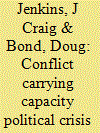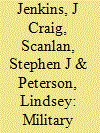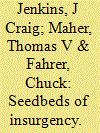|
|
|
Sort Order |
|
|
|
Items / Page
|
|
|
|
|
|
|
| Srl | Item |
| 1 |
ID:
065790


|
|
|
| 2 |
ID:
079919


|
|
|
|
|
| Publication |
2007.
|
| Summary/Abstract |
Discussions of world hunger have focused on economic growth and international food aid, assuming that food supply is the critical issue. The authors show that food access rooted in social stratification and military power is the central problem. Synthesizing the entitlement and military famine approaches to hunger, the authors examine the effects of food supply, economic growth, social stratification, and military power on child hunger in less developed countries (1990-2000) using a cross-national analysis. Child hunger is largely due to gender stratification, militarization, and armed conflict. Halting wars, expanding political rights, and improving gender equity reduce child hunger. Economic growth and programmatic international food aid reduce child hunger, but there are no benefits from increased total food supply or international emergency relief. Child hunger is an access problem best addressed by expanding social and political rights, reducing armed conflict and militarization, and improving women's status. Early warning and relief efforts should focus on these concerns instead of the ``supply'' concerns traditionally emphasized
|
|
|
|
|
|
|
|
|
|
|
|
|
|
|
|
| 3 |
ID:
133703


|
|
|
|
|
| Publication |
2014.
|
| Summary/Abstract |
Studies of insurgency and collective action are divided between structural and dynamic explanations. Structural theories address the presence of insurgency while dynamic theories focus on the frequency of insurgent actions. Yet prior studies often treat these arguments additively, leaving unclear how structural and dynamic processes affect these different aspects of insurgency. This study addresses this division by using zero-inflated negative binomial regression to examine in a single equation both the presence and the count of Islamist insurgency in Egyptian governorates between 1986 and 1999. We test political economy, moral economy, and cultural clash explanations of the presence of insurgency alongside political dynamics arguments about repression and exclusion to explain the count of attacks. Looking at the structural side of this equation, we find that communities with high rates of poverty, child mortality, cultural conservatism in terms of low contraceptive prevalence, and greater urban density are more likely to support insurgency. Looking at the dynamic side, parliamentary exclusion, security sweeps, and executions affect the count of attacks along with spatial diffusion from neighboring governorates. The culturally conservative region of Upper Egypt, which has a history of social and political marginality and opposition, provided a seedbed of insurgent support but this challenge broke down over time as repression intensified and exclusion was relaxed. These findings underscore the point that the presence of and the intensity of insurgency are distinct and driven by different factors. There are notable methodological and theoretical advantages to distinguishing between presence and count to better understand when and where insurgencies develop and their level of collective action.
|
|
|
|
|
|
|
|
|
|
|
|
|
|
|
|
|
|
|
|
|